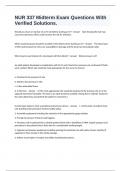Exam (elaborations)
NUR 337 Midterm Exam Questions With Verified Solutions.
- Course
- Institution
Should you shave or clip hair of an IV site before starting an IV? - Answer Clip! Shaving the hair may cause tiny abrasions which could increase the risk for infection. Which anatomical part should be avoided in the elderly when starting an IV? - Answer The dorsal part of the hand because ...
[Show more]



